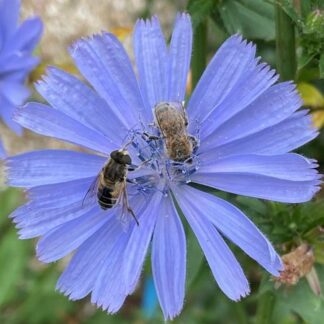Description
Poaceae(family)
Forage for Pollinators: Produces Pollen only (being a wind pollinated plant), and although normally grass pollen is not sought after by bees, it has been observed at Kew Gardens that Honeybees will favour this pollen above others from many flowers which are available at the same time, which was a surprise to many. Bumblebees benefit from areas of long grass, as they build their nests in the ground in long grass, such as the moss carder bee (Bombus muscorum), brown-banded carder bee (Bombus humilis), and often using old mouse holes are red-shanked carder bees (Bombus ruderarius). The tawny mining bee (Andrena fulva) on the other hand prefers bare patches in lawns or short grass, females digging burrows resembling tiny volcanoes of earth. The caterpillars of many butterfly species feed on cock’s foot, including:
Meadow Brown (Maniola jurtina),
Wall Brown (Lasiommata megera),
Gatekeeper (Pyronia tithonus),
Large Skipper (Ochlodes venata),
Essex Skipper (Thymelicus lineola),
Small Skipper (Thymelicus sylvestris),
Zabulon Skipper (Poanes zabulon),
Speckled Wood (Pararge aegeria), (Wikipedia)
Cocksfoot harbours a great many insect species, and is therefore one of the most important grass species.
Growing information: NATIVE PERENNIAL GRASS, growing 20-160cm tall and clump-forming. It grows early in the spring and thrives on light, free-draining soil but also on moist soil liable to flood. This grass continually produces young leaves, which means it can withstand heavy grazing, and is widely used for hay because of its high yields, protein and sugar content, making it sweeter than most other grasses though is palatable only when grazed frequently. It is drought tolerant and shade tolerant and therefore often used as a vegetation cover in orchards and vineyards across Europe. It’s an ideal companion grass for legumes in mixed permanent pastures (Ecocrop, 2010). It is suitable for mixed sowing with red clover (Trifolium pratense) for hay or white clover (Trifolium repens) for grazing (Sanada et al., 2010), though competes with white clover for water and nutrients, where the two species are grown together, with cocksfoot dominant pastures having lower nutritional value and being difficult to manage by grazing (Mills, 2007). Can be used as a ground cover, being a deep-rooted, long-lived perennial, to control soil erosion and for lawns or borders, and may also be used in rehabilitation applications. Due to its dominant presence in the sward, it is best to restrict its use to mixtures. It may be cultivated without fertilization and without pesticides once established. Sow any time of the year on bare soil (water if sown during drought). Sowing rate: 8 kg per acre (20 kg/ha, 2 g/m²).





